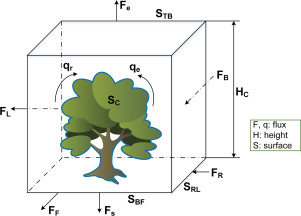Science of the Total Environment ( IF 9.8 ) Pub Date : 2018-10-18 , DOI: 10.1016/j.scitotenv.2018.10.243 Ting Cai , Yong Zhang , Xiang Ren , Leonard Bielory , Zhongyuan Mi , Christopher G. Nolte , Yang Gao , L. Ruby Leung , Panos G. Georgopoulos

|
Modeling pollen emission processes is crucial for studying the spatiotemporal distributions of airborne allergenic pollen. A semi-mechanistic emission model was developed based on mass balance of pollen grain fluxes in the surroundings of allergenic plants. The emission model considers direct emission and resuspension and accounts for influences of temperature, wind velocity, and relative humidity. Modules of this emission model have been developed and parameterized with multiple years of pollen count observations to provide pollen season onset and duration, hourly flowering likelihood, and vegetation coverage for oak and ragweed, as two examples. The simulated spatiotemporal pattern of pollen emissions generally follows the corresponding pattern of area coverage of allergenic plants and diurnal pattern of hourly flowering likelihood. It is found that oak pollen emissions start from the Southern part of the Contiguous United States (CONUS) in March and then shift gradually toward the Northern CONUS, with a maximum emission flux of 5.8 × 106 pollen/(m2 h). On the other hand, ragweed pollen emissions start from the Northern CONUS in August and then shift gradually toward the Southern CONUS. The mean ragweed emission flux during August to September can increased up to 2.4 × 106 pollen/(m2 h). This emission model is robust with respect to the input parameters for oak and ragweed. Qualitative evaluations of the model performance indicated that the simulated pollen emission is strongly correlated with the plant coverages and observed pollen counts. This model could also be applied to other pollen species given the relevant parameters.
中文翻译:

半机械致敏花粉排放模型的建立
花粉排放过程的建模对于研究机载致敏花粉的时空分布至关重要。基于变应原植物周围花粉粒通量的质量平衡,建立了半机械排放模型。排放模型考虑了直接排放和再悬浮,并考虑了温度,风速和相对湿度的影响。已开发了该排放模型的模块,并通过多年的花粉计数观测进行了参数化,以提供花粉的季节开始和持续时间,每小时开花的可能性以及橡树和豚草的植被覆盖率,这是两个示例。花粉排放的模拟时空模式通常遵循相应的变应原植物面积覆盖模式和每小时开花可能性的昼夜模式。6 花粉/(m 2 h)。另一方面,豚草花粉的排放量从8月的北部CONUS开始,然后逐渐向南部CONUS转移。8月至9月的豚草平均排放通量可以增加到2.4×10 6 花粉/(m 2 h)。该排放模型相对于橡树和豚草的输入参数具有鲁棒性。对模型性能的定性评估表明,模拟花粉排放量与植物覆盖率和观察到的花粉数量密切相关。给定相关参数,该模型也可以应用于其他花粉种类。


























 京公网安备 11010802027423号
京公网安备 11010802027423号